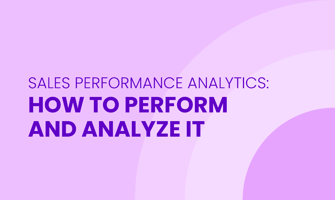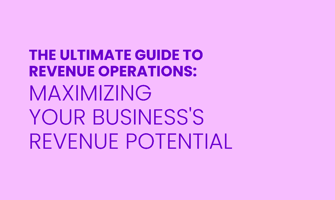Sales performance analytics helps businesses track, measure, and improve sales strategies. By...
What is Revenue Intelligence? How It Works and Why It Matters
Revenue intelligence is a critical process that helps businesses understand, predict, and optimize their revenue by using data.
By analyzing sales, marketing, and customer interactions, businesses can make smarter decisions and focus on activities that drive growth.
From selecting the right revenue intelligence tools to understanding customer behavior, this article will tell you everything you need to know about how revenue intelligence works, its importance, and how businesses can use it to improve performance.
What is Revenue Intelligence?
Revenue intelligence is the process of using data to understand, predict, and improve a company’s revenue. It involves collecting and analyzing information from sales, marketing, and customer interactions to make better decisions.
Platforms such as 180ops specialize in consolidating this data to provide businesses with a clear path to revenue growth.
How It Works:
Data Collection: Revenue intelligence tools gather data from emails, phone calls, CRM systems, and other platforms. These tools track customer behavior, sales performance, and trends.
Analysis: The data is then analyzed to uncover patterns, like which sales techniques work best or what type of customers bring the most revenue.
Actionable Insights: Businesses use these insights to adjust their strategies, such as improving sales pitches, targeting specific customer groups, or refining marketing campaigns.
Why It Matters:
Better Decision-Making: Revenue intelligence helps businesses focus on activities that drive growth while avoiding ineffective ones.
Improved Sales Performance: By understanding what works, sales teams can close deals faster and more efficiently.
Enhanced Customer Experience: Insights from customer behavior help businesses offer personalized solutions, keeping customers satisfied and loyal.
![]()
Identify Key Features of a Revenue Intelligence Platform
A revenue intelligence platform is a tool designed to provide businesses with actionable insights from their sales and revenue data. These platforms analyze customer behavior, sales patterns, and deal performance to help companies identify growth opportunities and challenges.
Choosing the right platform is essential for optimizing revenue processes and gaining a competitive edge. When selecting a revenue intelligence platform, it’s crucial to focus on its features, compatibility, and scalability.
Start by identifying your business's specific needs. Does your sales team need better forecasting tools? Or is the goal to enhance pipeline visibility? Prioritizing your requirements ensures you invest in a solution that aligns with your objectives.
Next, evaluate the platform's integration capabilities. A good revenue intelligence platform should seamlessly connect with your existing CRM and sales tools.
This eliminates redundant data entry and ensures all systems work harmoniously. Data visualization and analytics features are equally important. A platform that offers intuitive dashboards and real-time analytics allows your team to make informed decisions quickly.
Choose a tool that allows customizable reports to track metrics relevant to your business. Ensure it is scalable to accommodate growth, handling increased data volumes and offering advanced features like AI-driven insights and predictive analytics. Select a solution that evolves with your needs.
Finally, don’t overlook user experience. A platform that’s easy to navigate encourages adoption among your team, maximizing its effectiveness. Request demos and trials to ensure the software meets your expectations.
Understanding Revenue Trend Analysis
Analyzing revenue trends means looking at how a company’s income changes over time. Companies make money by selling their products or services, and this income is called revenue. By studying patterns in revenue, businesses can see if they are earning more, less, or the same over months or years.
This is important because it helps companies understand what they are doing well and what needs improvement. For example, if revenue is going up, it might be because customers like a new product. If revenue is going down, it could mean fewer people are buying or costs are too high.
Businesses can analyze revenue trends by collecting data from their sales records. They look at numbers for different periods, like each month, season, or year. They also compare revenue from different products, stores, or customer groups. Charts and graphs are often used to make it easier to see patterns.
Once companies understand their revenue trends, they can make better decisions. For instance, if a company sees a drop in sales during a certain season, they might plan special offers during that time next year.
Or, if a new product is doing well, they might invest more money in making and advertising it.
Expert tools, such as spreadsheets and software, can make trend analysis faster and more accurate. These tools also assist businesses in forecasting future outcomes based on past trends.
Learn Why Customer Retention Metrics Matter
Measuring customer retention means keeping track of how many customers continue to buy from a business over time. Customer retention metrics are numbers or percentages that show how well a business is holding onto its customers.
Here are some common customer retention metrics:
Customer Retention Rate (CRR): This shows the percentage of customers a business keeps over a certain time. A high CRR means customers are staying.
Customer Churn Rate: This tells how many customers leave the business during a specific time. A low churn rate is good.
Repeat Purchase Rate: This shows how often customers buy again after their first purchase.
Lifetime Value (LTV): This measures how much money a customer is likely to spend over their entire relationship with the business.
Customer retention metrics matter because it’s usually cheaper and easier to keep current customers than to find new ones. Loyal customers often buy more and recommend the business to their friends. When customers are happy, they help the business grow through positive reviews and referrals.
Businesses can improve their customer retention by offering excellent service, listening to feedback, and rewarding loyalty with discounts or special offers. They can also use these metrics to spot problems early.
For example, if the churn rate is going up, the company knows it needs to find out why customers are leaving and fix the issue.
Measuring customer retention metrics is like checking the health of a business. It shows what’s working and what needs to improve. Just like taking care of a garden ensures plants grow strong, paying attention to customer retention metrics helps a business grow successfully.
Predict Customer Lifetime Value
Predicting customer lifetime value (CLV) means estimating how much money a customer will spend on a company’s products or services during their entire relationship.
It’s like trying to figure out how valuable a customer will be over time. This prediction helps businesses plan better and make smart decisions about their customers.
Focus on Valuable Customers: By knowing which customers will spend more, businesses can give special attention to them, like offering discounts or personalized services.
Smart Budgeting: Companies can spend their money wisely. For example, they can spend more on advertising to attract customers who are likely to stay longer and buy more.
Better Decision-Making: CLV predictions guide businesses in deciding how much to invest in keeping current customers happy or attracting new ones.
To predict CLV, businesses collect data about their customers, like how often they buy, how much they spend, and how long they usually stay as customers.
Then, they use tools like math formulas or software to calculate the predicted value. For example, if a customer spends $50 every month and usually stays for two years, their CLV would be $50 x 24 months = $1,200.
Applications of CLV Prediction:
Marketing Strategies: Businesses can design special offers or loyalty programs for high-value customers to keep them happy.
Product Development: Companies can learn what products high-value customers like and create more similar items.
Customer Support: Businesses can provide better support to customers predicted to bring more value over time.
Resource Allocation: Companies can allocate more resources, like advertising budgets, to attract customers with higher CLV.
![]()
Importance of Revenue Attribution Models
Revenue attribution models are methods businesses use to figure out which marketing or sales activities contribute to making money. Think of it like tracing back to see which steps helped a customer decide to buy something.
These models help companies understand which strategies are working and where to invest more effort.
Types of Revenue Attribution Models:
First-Touch Attribution: This gives all the credit to the first interaction, like when a customer first clicks on an ad.
Last-Touch Attribution: This assigns all the credit to the final step before the sale, like the last email or ad a customer sees.
Multi-Touch Attribution: This spreads the credit across all the interactions a customer has, such as ads, emails, and website visits.
Why are revenue attribution models important?
Understand Customer Journeys: These models show how customers move through different marketing channels, helping businesses see what works best at each stage.
Optimize Marketing Budgets: By knowing which activities drive revenue, businesses can spend their money on the most effective channels, like ads or emails.
Improve Sales Strategies: Sales teams can use these insights to focus on what’s bringing in customers, like specific offers or product features.
To use revenue attribution models, businesses track customer interactions using tools like analytics software. They collect data on things like website visits, ad clicks, and purchases. Then, they choose a model to analyze the data and see which activities contributed the most to the revenue.
Revenue attribution models are like solving a puzzle. Each piece (or customer interaction) helps businesses see the bigger picture of what’s driving sales.
Learn Key Aspects of Revenue Optimization
Revenue optimization means finding ways to earn the most money while keeping customers happy. Businesses do this by adjusting prices, improving their products or services, and focusing on what customers need. The goal is to balance earning more money and delivering value to customers.
Increases Profits: By making smart changes, businesses can earn more without spending too much extra.
Improves Customer Satisfaction: When companies offer the right products or services at the right price, customers are more likely to buy again.
Helps in Planning: Optimizing revenue gives businesses better ideas for setting goals and strategies for growth.
Businesses start by looking at data, such as sales numbers, customer feedback, and market trends. They analyze this information to figure out what is working and what isn’t. For example, they might notice that customers are buying more during sales or that a particular product is very popular.
Next, they test strategies to see what works best. This could include changing prices, offering discounts, or bundling products together. Businesses also focus on keeping customers loyal by improving service or creating loyalty programs.
Tools like data analysis software and customer management systems can help businesses track performance and measure the impact of their changes. Revenue optimization is not a one-time task; it’s a continuous process where companies keep adjusting to improve results.
Implement Effective Revenue Growth Techniques
Increasing revenue means finding ways to earn more money from selling products or services. Businesses use specific strategies to attract more customers, keep existing ones, and encourage them to buy more. These strategies focus on improving sales, pricing, and customer relationships.
Supports Business Expansion: More revenue allows businesses to invest in new products, locations, or staff.
Ensures Stability: Consistent growth helps businesses handle tough times and unexpected costs.
Attracts Investors: Growing revenue shows the business is doing well, making it attractive to investors.
How do we increase business revenue?
Attract More Customers: Businesses can use marketing campaigns, advertisements, and promotions to reach new audiences. For example, social media and online ads can help bring in more people.
Improve Customer Retention: Keeping current customers is often easier and cheaper than finding new ones. Businesses can offer loyalty programs, excellent customer service, and personalized deals to make customers come back.
Upselling and Cross-Selling: Upselling is encouraging customers to buy a higher-priced item, while cross-selling is suggesting related products. For instance, if someone buys a phone, suggesting a case and screen protector increases sales.
Adjust Pricing Strategies: Offering discounts during slow seasons or bundling products together can attract more buyers. Businesses can also review their pricing to ensure they’re competitive but profitable.
Expand Product or Service Lines: By adding new items or services, businesses can appeal to different customer needs and boost revenue.
Use Technology and Tools: Data analysis tools help identify what’s working and what needs improvement, making it easier to adjust strategies.
Learn the Principles of Revenue Attribution
Revenue attribution is a way for businesses to figure out which activities or efforts are responsible for bringing in money. It’s like connecting the dots between a company’s marketing, sales, or customer interactions and the revenue they earn.
Principles of Revenue Attribution:
Track Customer Journeys: Every customer goes through steps before making a purchase, like clicking on ads, reading emails, or visiting websites. Revenue attribution tracks these steps to find out which ones matter most.
Assign Credit: Different models assign credit for revenue to specific actions. For example:
First-Touch Model: Gives all the credit to the first customer interaction.
Last-Touch Model: Gives all the credit to the final action before the sale.
Multi-Touch Model: Shares credit among all actions in the customer’s journey.
Use Data for Insights: Accurate tracking and analysis of customer data are essential to make informed decisions.
Why does it matter?
Better Investment Decisions: Businesses can see which marketing or sales activities drive revenue and invest more in those areas.
Improved Customer Understanding: It shows how customers find and decide to buy, helping businesses improve their strategies.
Optimized Campaigns: By identifying the most effective channels, businesses can refine their campaigns to increase returns.
Businesses track data using revenue attribution tools like websites, ads, and customer management systems. They choose a model to analyze the data and determine the impact of each activity on revenue.
For instance, if an ad campaign leads to more sales, the company knows to keep or expand that campaign.
Explore How the Revenue Operations Framework Functions
A revenue operations (RevOps) framework is a way for businesses to organize their sales, marketing, and customer success teams so they can work together smoothly. The goal is to help businesses make more money by improving how these teams share information, plan, and work toward common goals.
Key Components of RevOps:
Data Management: Collecting and organizing data from different departments, such as sales and marketing, helps businesses make smarter decisions. Accurate data ensures all teams are on the same page.
Tools and Technology: Software like customer relationship management (CRM) tools or analytics platforms help teams track performance and identify areas to improve.
Aligned Goals: RevOps ensures all departments have the same objectives, like increasing customer retention or boosting sales. This alignment reduces confusion and improves efficiency.
Process Optimization: RevOps streamlines workflows, making tasks like tracking leads or managing customer accounts faster and more effective.
The RevOps framework works by breaking down silos between teams. Instead of sales, marketing, and customer success working separately, they share insights and data to achieve unified goals.
For example, if marketing sees that a certain type of content is attracting leads, they inform sales so the team can follow up effectively.
RevOps also focuses on tracking the customer journey, from the first interaction to the final sale and beyond. This helps teams identify what’s working and what needs to improve. Tools and data analysis are used to measure performance, forecast revenue, and adjust strategies.
Boosts Revenue: RevOps makes it easier to find and fix inefficiencies, leading to higher earnings.
Improves Customer Experience: A smoother, unified approach keeps customers happy and loyal.
Drives Growth: Teams working together can scale the business faster.
Conclusion
Revenue intelligence empowers businesses to make data-driven decisions, streamline operations, and enhance customer experiences.
Using platforms like 180ops, companies can unlock actionable insights, improve their strategies, and achieve sustainable growth. With the right tools and approaches, businesses can confidently optimize their revenue processes for long-term success.
By effectively collecting and analyzing data, companies can uncover insights that lead to better strategies, increased sales, and long-term growth. Implementing the right tools and frameworks is essential to achieving these outcomes.
With the principles and applications explained in this article, businesses can confidently embrace revenue intelligence to achieve their financial goals and maintain a competitive edge.
FAQ
What is revenue intelligence?
Revenue intelligence is the process of using data from sales, marketing, and customer interactions to understand, predict, and improve a company's revenue. It provides actionable insights that help businesses make smarter decisions.
Why is revenue intelligence important for businesses?
Revenue intelligence is important because it helps businesses identify what drives revenue, optimize sales strategies, and enhance customer satisfaction. It allows companies to focus on effective activities while avoiding wasteful efforts.
How do revenue intelligence tools work?
Revenue intelligence tools collect data from platforms like CRM systems, emails, and phone calls. They analyze this data to uncover patterns and provide actionable insights to improve sales and marketing efforts.
What should businesses look for in a revenue intelligence platform?
Businesses should look for features like seamless integration with existing tools, real-time data analytics, customizable reports, and scalability. A user-friendly platform encourages adoption and maximizes its effectiveness.
How does revenue intelligence improve customer experience?
By analyzing customer behavior and preferences, revenue intelligence helps businesses provide personalized solutions, better support, and relevant offers. This improves customer satisfaction and loyalty.




